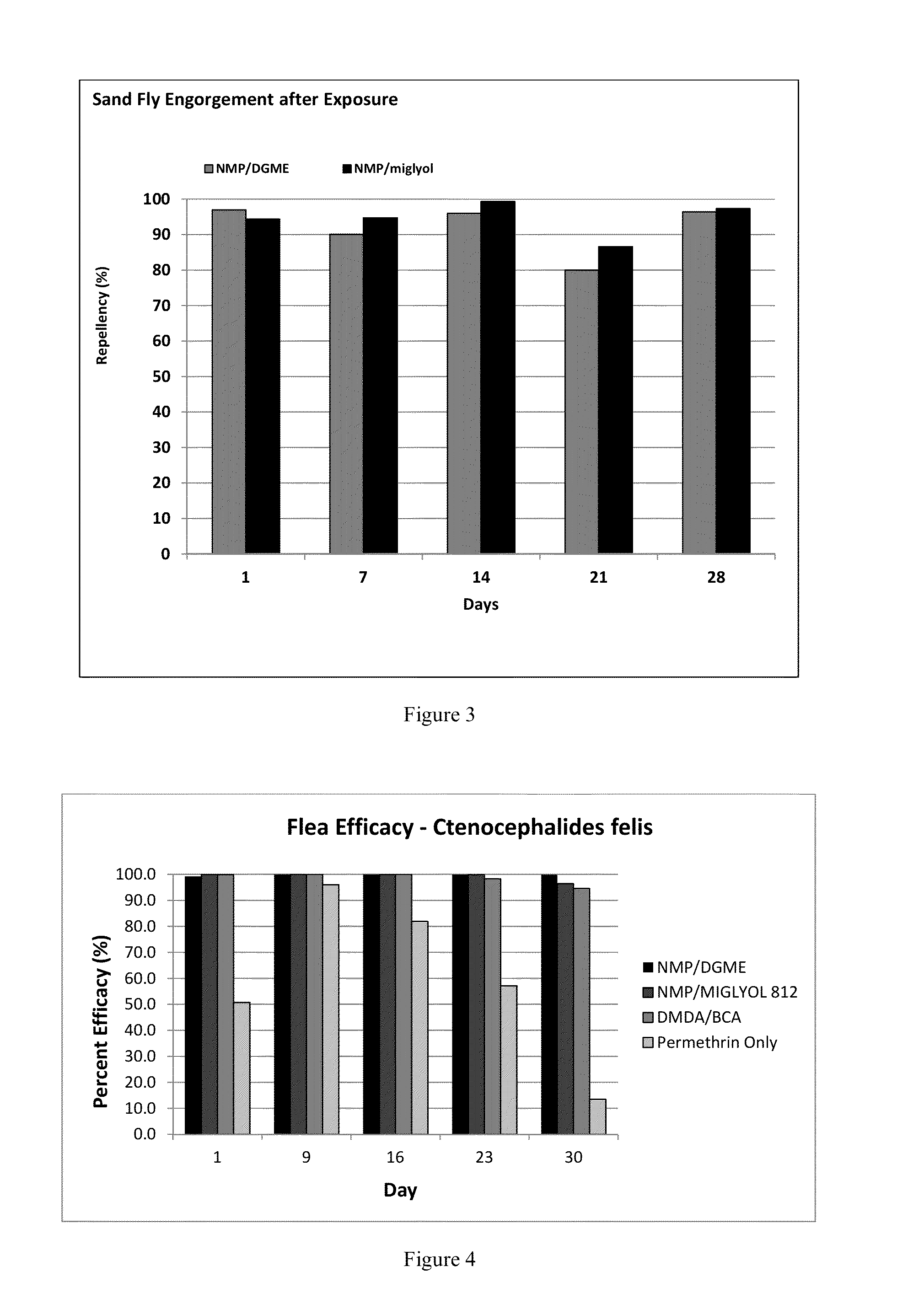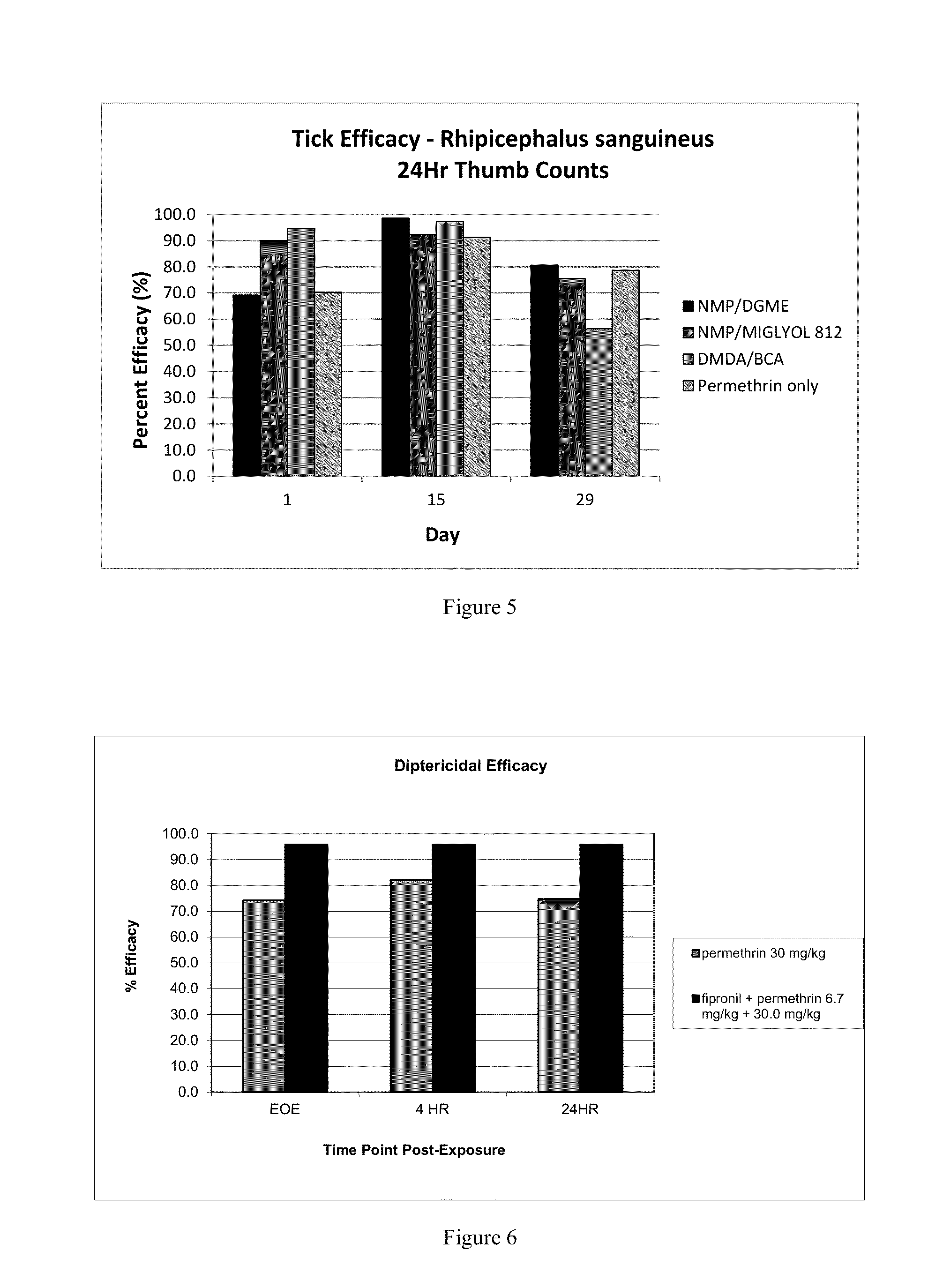Topical compositions comprising fipronil and permethrin and methods of use
a technology of permethrin and fipronil, which is applied in the field of pharmaceutical and veterinary formulations, can solve the problems of reducing productivity, illness and death, and affecting the ability of domesticated animals to resist parasite infestation, and achieve the effect of improving repellency and efficacy
- Summary
- Abstract
- Description
- Claims
- Application Information
AI Technical Summary
Benefits of technology
Problems solved by technology
Method used
Image
Examples
example 1
Stable Fly Repellency and Parasiticidal Efficacy in Rats
[0174]This study evaluated the effectiveness of a formulation of the invention containing fipronil and permethrin to repel and kill Stomoxys calcitrans on rats after a single administration. Rats in the treatment group (Group 2) were treated once on Day 0 with a topical formulation of the invention containing 9.2 (w / w) fipronil and 41.5% (w / w) permethrin in a solvent system containing DMDA and DGME in a ratio of 0.73:1, DMDA to DGME, to deliver a dose of 30 mg / kg permethrin and 6.7 mg / kg fipronil. Rats in Group 3 were treated with a formulation containing permethrin alone to deliver a dose of 30 mg / kg. The two treatment groups were compared with a control group treated with a solvent system placebo.
[0175]Flies are exposed to the treated rats for 1 hr., then removed. Dead flies are counted at the end of the exposure period and at 4 hr and 24 hr post-exposure. The fipronil+permethrin group exhibited a very high level of efficacy ...
example 2
Stable Fly Repellency and Parasiticidal Efficacy on Dogs
[0177]This study evaluated the effectiveness of Fipronil+permethrin to repel and kill Stomoxys calcitrans on dogs after a single administration.
[0178]The fly repellency and parasiticidal activity of a formulation of the invention was evaluated on ten dogs. Dogs were randomly allocated to one of two groups by lottery. Dogs in Group 1 were not treated: Dogs in Group 2 received the topical formulation of the invention containing a combination of fipronil and permethrin described in Table 3 below, administered topically once on Day 0 in a single spot to deliver a dose of approximately 6.70 mg fipronil / kg and 30.15 mg permethrin / kg.
TABLE 3FormulationIngredient% w / v% w / wfipronil109.2Permethrin4541.5Dimethyl decanamideQS~49(DMDA):Diethylene glycolmonoethyl ether (DGME) at0.7:3:1 (w / w)
[0179]On Days 1, 14, 21 and 28, dogs were exposed to approximately 100 three to seven day old S. calcitrans. After approximately 60 minutes, live flies w...
example 3
Crystallization of Actives
[0184]Four experimental formulations were prepared with 6% w / w Fipronil and 44.9% w / w permethrin and varying amounts of excipients N-dimethyldecanamide (DMDA) and diethylene glycol monoethyl ether (DGME). The DMDA concentration was varied between 5-20% w / w. These formulations were subjected to different low temperature conditions including −20° C., 4° C., and 10° C.; some samples were seeded with crystals that had grown in previous batches. Crystallization was seen among all the formulations in various conditions.
[0185]A DMDA-containing formulation of fipronil and permethrin as described herein was subjected to low temperatures. Some samples were seeded with crystals. Crystals were seen in the DMDA formulation.
[0186]Solvents were screened for their compatibility with permethrin and ability to maintain permethrin in solution. The summary of the testing and results are shown in Table 5.
TABLE 5SolventCrystalsCaptex 170 (Caprylic / Capric acid100%Ester)Oleic acid...
PUM
| Property | Measurement | Unit |
|---|---|---|
| volume | aaaaa | aaaaa |
| time | aaaaa | aaaaa |
| temperatures | aaaaa | aaaaa |
Abstract
Description
Claims
Application Information
 Login to View More
Login to View More - R&D
- Intellectual Property
- Life Sciences
- Materials
- Tech Scout
- Unparalleled Data Quality
- Higher Quality Content
- 60% Fewer Hallucinations
Browse by: Latest US Patents, China's latest patents, Technical Efficacy Thesaurus, Application Domain, Technology Topic, Popular Technical Reports.
© 2025 PatSnap. All rights reserved.Legal|Privacy policy|Modern Slavery Act Transparency Statement|Sitemap|About US| Contact US: help@patsnap.com



